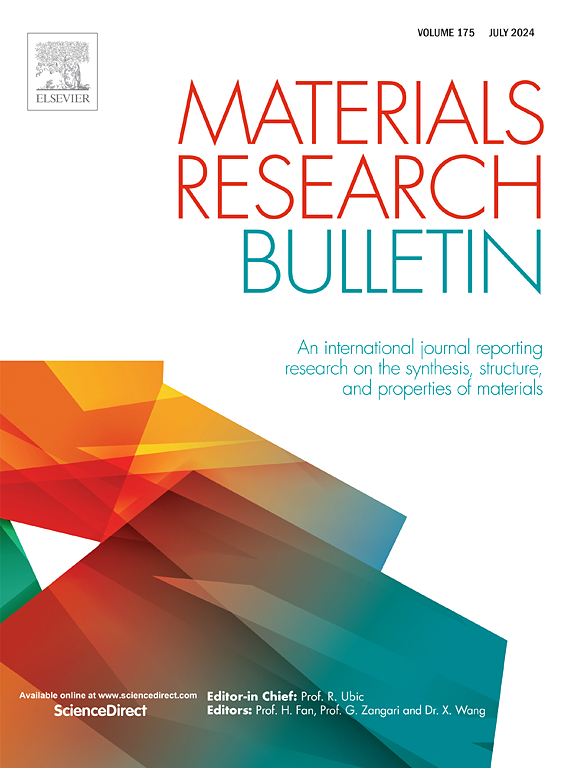Optical nonlinearity and laser protection potential of transition and rare earth doped YCrO4 nanoparticles
IF 5.3
3区 材料科学
Q2 MATERIALS SCIENCE, MULTIDISCIPLINARY
引用次数: 0
Abstract
This study investigates the nonlinear optical (NLO) properties of YCrO4 (YC), YCrO4:Zn (9 mol%) (YCZ), YCrO4:Ni (9 mol%) (YCN), YCrO4:Eu (9 mol%) (YCE), and YCrO4:Tb (9 mol%) (YCT) NPs. These NPs are synthesized by Aloe vera gel extract mediated solution combustion method. The X-ray diffraction patterns of YCrO4 confirm the formation of tetragonal phase with the space group I 141/amd. No other impurity related peaks were observed even after doping with transition/rare earth metal ions except the variation in intensity. Lattice distortion in the host lattice due to the addition of dopants leads to slight shifting of Bragg peaks towards lower angle side. The direct optical band gap of YC, YCZ, YCN, YCE and YCT were tuned to 3.08, 3.05, 2.96, 2.86 and 2.75 eV respectively. The nonlinear absorption coefficient and optical limiting behavior were analyzed using the Z-scan technique under high-intensity laser irradiation. The results reveal significant variations in the nonlinear absorption coefficient among the samples, indicating the influence of dopants on the material’s NLO performance. Among them, YCN exhibited the highest nonlinear absorption coefficient (14 m/W), demonstrating its strong reverse saturable absorption (RSA) characteristics. The optical limiting thresholds were also evaluated, showing that YCN had the lowest threshold (2.02 W/m2), making it a promising candidate for laser protection applications. These findings suggest that doping YCrO4 with specific elements such as Ni enhances its nonlinear optical response, making it suitable for advanced photonic and optoelectronic applications.

跃迁和稀土掺杂YCrO4纳米粒子的光学非线性和激光保护电位
本文研究了YCrO4 (YC)、YCrO4:Zn (9 mol%) (YCZ)、YCrO4:Ni (9 mol%) (YCN)、YCrO4:Eu (9 mol%) (YCE)和YCrO4:Tb (9 mol%) (YCT)纳米粒子的非线性光学性质。这些NPs是用芦荟凝胶提取物介导溶液燃烧法合成的。YCrO4的x射线衍射图证实其形成了具有I 141/amd空间群的四方相。在掺杂过渡态/稀土金属离子后,除强度变化外,未观察到其他与杂质相关的峰。由于掺杂剂的加入导致主晶格中的晶格畸变,导致Bragg峰向低角度侧轻微移动。YC、YCZ、YCN、YCE和YCT的直接光学带隙分别调至3.08、3.05、2.96、2.86和2.75 eV。利用z扫描技术分析了高强度激光照射下的非线性吸收系数和光限行为。结果表明,不同样品的非线性吸收系数存在显著差异,表明掺杂剂对材料NLO性能的影响。其中,YCN非线性吸收系数最高(14 m/W),表现出较强的反向饱和吸收(RSA)特性。光限制阈值也进行了评估,表明YCN具有最低的阈值(2.02 W/m2),使其成为激光防护应用的有希望的候选者。这些发现表明,在YCrO4中掺杂特定元素(如Ni2+)可以增强其非线性光学响应,使其适合于先进的光子和光电子应用。
本文章由计算机程序翻译,如有差异,请以英文原文为准。
求助全文
约1分钟内获得全文
求助全文
来源期刊

Materials Research Bulletin
工程技术-材料科学:综合
CiteScore
9.80
自引率
5.60%
发文量
372
审稿时长
42 days
期刊介绍:
Materials Research Bulletin is an international journal reporting high-impact research on processing-structure-property relationships in functional materials and nanomaterials with interesting electronic, magnetic, optical, thermal, mechanical or catalytic properties. Papers purely on thermodynamics or theoretical calculations (e.g., density functional theory) do not fall within the scope of the journal unless they also demonstrate a clear link to physical properties. Topics covered include functional materials (e.g., dielectrics, pyroelectrics, piezoelectrics, ferroelectrics, relaxors, thermoelectrics, etc.); electrochemistry and solid-state ionics (e.g., photovoltaics, batteries, sensors, and fuel cells); nanomaterials, graphene, and nanocomposites; luminescence and photocatalysis; crystal-structure and defect-structure analysis; novel electronics; non-crystalline solids; flexible electronics; protein-material interactions; and polymeric ion-exchange membranes.
 求助内容:
求助内容: 应助结果提醒方式:
应助结果提醒方式:


